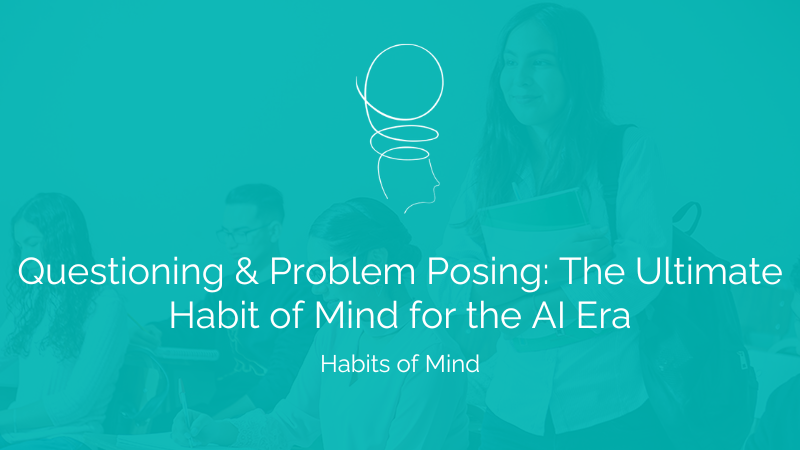How do your students respond when faced with a difficult problem or challenging task? Do they lean in with interest or pull back with hesitation? Their response reveals much about their relationship with challenge—and the classroom culture that shapes it.
If Challenge Were a Person
Try this thought experiment: If “Challenge” were a new student joining your class, how would other students treat them? Would they be welcomed or avoided? What would their social status be?
I’ve posed this question to hundreds of educators, and the answers are remarkably consistent:
“Challenge would sit alone at lunch.” “The other kids would avoid working with them.” “No one would choose them for group projects.” “They might even get bullied to make them go away.”
This personification reveals a profound truth: in most learning environments, challenge is viewed as an unwelcome visitor rather than a valued friend.
What Shapes This Relationship?
How did challenge get such a bad reputation? Several factors contribute:
- Our language betrays our attitude. We apologize for challenging work: “Sorry, I know this is difficult…” We frame it as something to be endured: “Once we get through this hard part…”
- We celebrate the wrong things. We praise quick, correct answers more enthusiastically than persistent efforts on difficult problems.
- We create negative consequences for struggle. When students encounter difficulty, they often face lower grades, public correction, or subtle signals of disappointment.
- We act as rescuers. By quickly stepping in when students struggle, we unintentionally communicate that difficulty is something to be avoided or escaped.
- We don’t equip students for challenge. Without the necessary thinking tools and strategies, challenge naturally feels threatening rather than stimulating.
The Friendship We Want to Foster
In my work on Learnership—the expertise one develops in learning itself—I’ve found that skilled learners have a fundamentally different relationship with challenge. They don’t just tolerate challenge; they actively seek it out, understanding that it’s the pathway to growth.
This is what I call becoming a “creature of discomfort”—someone who recognizes that temporary discomfort in the Learning Zone leads to lasting capability development.
Transforming the Relationship
So how do we help students develop a friendship with Challenge? Here are five practical approaches:
1: Change Your Language
Pay attention to how you talk about difficulty in your classroom:
Instead of: “I know this might be challenging, but try your best.” Try: “This challenge is designed to help you grow. I’m excited to see your thinking develop.”
Instead of: “Sorry, I know this is hard.” Try: “This is where the real growth happens—when you’re working at the edge of your current abilities.”
2: Create Challenge Celebrations
Develop explicit practices that celebrate engagement with challenge:
- Create a “Challenge Champion” recognition for students who choose difficult tasks
- Implement “beautiful struggle” shares where students discuss challenging problems
- Highlight “growth moments” when something that was once difficult becomes easier
3: Tell Better Stories
The narratives we share shape how students perceive challenges:
- Share stories of people who embraced difficulty and grew stronger
- Tell your own stories of productive struggle and growth
- Highlight current students’ journeys through challenge to capability
4: Develop Problem-Solving Superpowers
Equip students with the Habits of Mind they need to tackle challenges effectively:
- Teach persistence strategies explicitly
- Develop flexible thinking approaches
- Build metacognitive awareness of learning processes
5: Design for Graduated Challenge
Create experiences that help students build positive associations with challenge:
- Start with achievable challenges that build confidence
- Gradually increase difficulty while maintaining support
- Provide choice about which challenges to tackle
- Ensure early success with new types of challenges
Making It Visible
Visual reminders can help reinforce this culture shift:
- Create a “Challenge as Friend” bulletin board with personified images and quotes
- Develop a class motto about challenge: “We grow through challenge!”
- Use a visual thermometer showing the “just right” challenge level
- Post before/after examples showing how challenge leads to growth
From Adversary to Ally
The transformation we’re seeking is profound: we want to move challenge from being perceived as an adversary to being embraced as an ally. We want students to recognize that challenge isn’t something that happens to them—it’s something that happens for them.
This shift doesn’t happen overnight, but with consistent messaging, deliberate practice, and thoughtful classroom design, we can help students develop a friendship with challenge that will serve them throughout their lives.
Extending to Home and Community
Teachers can also help parents understand this important shift. When parents report that their child is “stressed” about challenging work, use it as an opportunity to discuss the difference between productive discomfort and harmful anxiety. Help them see that developing a positive relationship with challenge at home reinforces classroom efforts.
Suggest language parents can use: “I’m proud of you for sticking with something challenging.” “It’s normal for new learning to feel difficult at first.” “What strategy might help you with this challenge?”
The Ultimate Goal
The goal isn’t just academic achievement. It’s developing learners who are equipped to thrive in an increasingly complex world because they see challenges as opportunities to grow stronger rather than threats to be avoided.
By transforming how students relate to challenge, we prepare them not just for school success, but for a lifetime of learning, adaptation, and growth.
How do you help your students develop a friendship with challenge? What practices have you found effective in creating a challenge-positive classroom culture?
This post is part of the “From a Safe Place to a Growth Place” series, exploring how our language and approaches shape student attitudes toward difficulty and growth. For more on developing powerful learners, check out my book “Learnership.”



